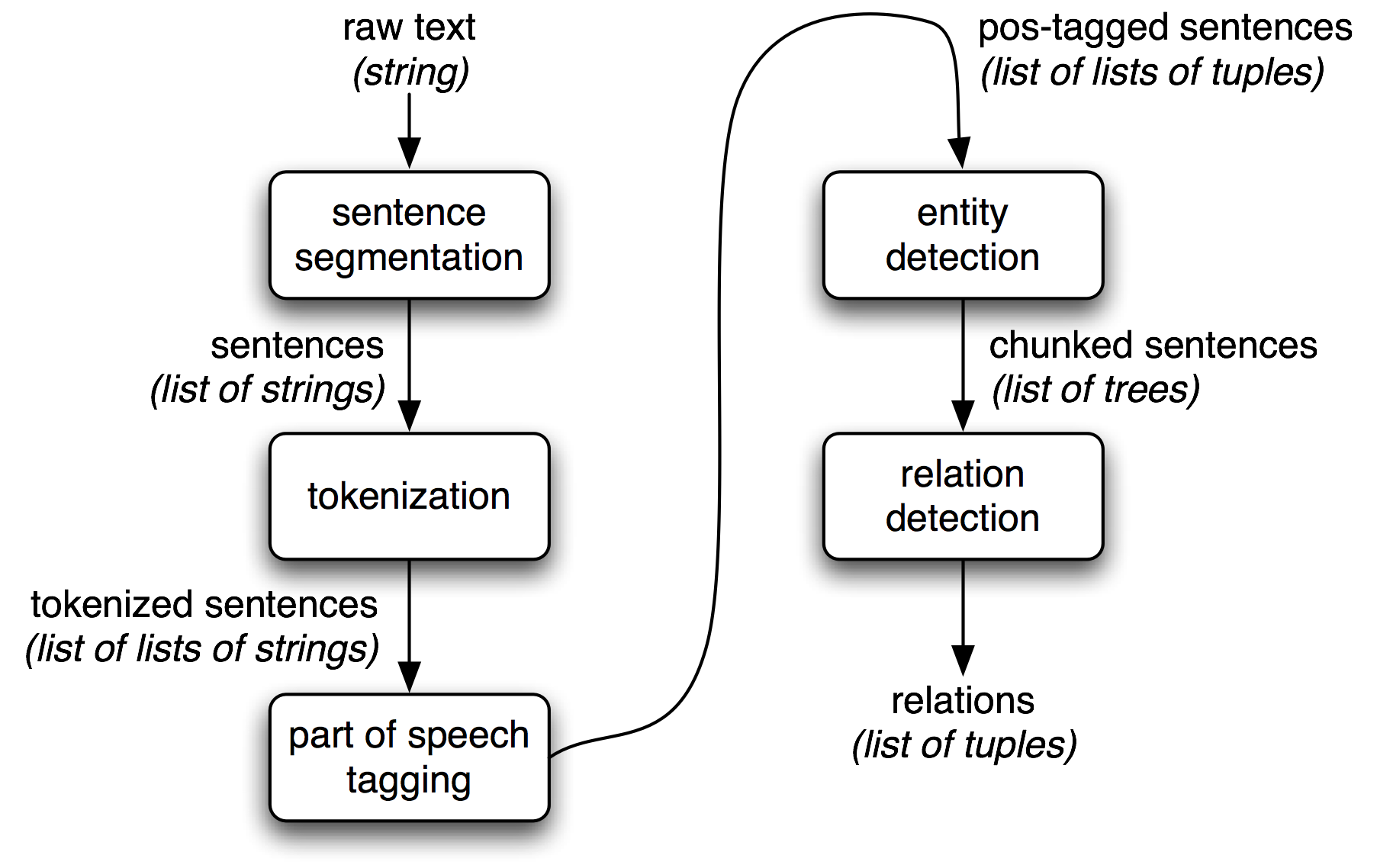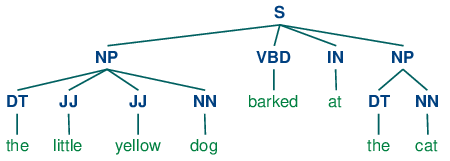NLTK學習之四:文字資訊抽取
1 資訊抽取
從資料庫中抽取資訊是容易的,但對於從自然文字中抽取資訊則不那麼直觀。通常資訊抽取的流程如下圖:

它開始於分句,分詞。接下來進行詞性標註,識別其中的命名實體,最後使用關係識別搜尋相近實體間的可能的關係。
2 分塊
分塊是實體識別(NER)使用的基本技術,詞性標註是分塊所需的最主要資訊。本節以名詞短語(NP)為例,展示如何分塊。類似的還可以對動詞短語,介詞短語等進行分塊。下圖展示了NP分塊的概念。

分塊可以簡單的基於經驗,使用正則表示式來匹配,也可以使用基於統計的分類演算法來實現。主節先介紹NLTK提供的正則分塊器。
2.1 基於正則的匹配
NLTK提供了一個基於詞性的正則解析器RegexpParser,可以通過正則表示式匹配特定標記的詞塊。每條正則表示式由一系列詞性標籤組成,標籤以尖括號為單位用來匹配一個詞性對應的詞。例如<NN>
<NN.*>來表示所有名詞的匹配。下面的程式碼演示了匹配上圖中冠詞-形容詞-名詞構成的短語塊。
import nltk
sent = sentence = [("the", "DT"), ("little", "JJ"), ("yellow", "JJ"),("dog", "NN"), ("barked", "VBD"), ("at", "IN"), ("the", "DT"), ("cat", "NN")]
grammer = 'NP:{<DT>*<JJ>*<NN>+}' 
2.2 處理遞迴
為了支援語言結構的遞迴,匹配規則是支援引用自身的,如下面的程式碼,先定義了NP的規則,而在VP和CLAUSE的定義中,互相進行了引用。
import nltk
grammar = r"""
NP: {<DT|JJ|NN.*>+}
PP: {<IN><NP>}
VP: {<VB.*><NP|PP|CLAUSE>+$}
CLAUSE: {<NP><VP>}
""" 3 基於分類的分塊器
本節將使用nltk.corpus的conll2000語料來訓練一個分塊器。conll語料使用IOB格式對分塊進行了標註,IOB是Inside,Outside,Begin的縮寫,用來描述一個詞與塊的關係,下圖是一個示例。

語料庫中有兩個檔案:train.txt,test.txt。另外語料庫提供了NP,VP和PP的塊標註型別。下表對此語料類的方法進行解釋:
| 方法 | 作用 |
|---|---|
| tagged_sents(fileid) | 返回詞性標註的句子列表,列表元素(word,pos_tag) |
| chunked_sents(fileid,chunk_types) | 返回IOB標記的語樹tree,樹的節點元素(word,pos_tag,iob_tag) |
下表對nltk.chunk包提供工具方法進行介紹:
| 方法 | 作用 |
|---|---|
| tree2conlltags(tree) | 將conll IOB樹轉化為三元列表 |
| conlltags2tree(sents) | 上面方法的逆,將三元組列表轉為樹 |
下面的程式碼使用最大熵分類器訓練一個iob標記分類器,然後利用標記進行分塊。分類器的訓練資料格式為((word,pos_tag),iob_tag),經過學習,分類器就可以對新見到的(word,pos_tag)對進行iob分類,從而打上合適的標籤。
import nltk
from nltk.corpus import conll2000
# define feature base on pos and prevpos
def npchunk_features(sentence, i, history):
word, pos = sentence[i]
if i == 0:
prevword, prevpos = "<START>", "<START>"
else:
prevword, prevpos = sentence[i-1]
return {"pos": pos, "prevpos": prevpos}
# A tagger based on classifier uses pos info
class ContextNPChunkTagger(nltk.TaggerI):
def __init__(self, train_sents):
train_set = []
for tagged_sent in train_sents:
untagged_sent = nltk.tag.untag(tagged_sent)
history = []
for i, (word, tag) in enumerate(tagged_sent):
featureset = npchunk_features(untagged_sent, i, history)
train_set.append((featureset, tag))
history.append(tag)
self.classifier = nltk.MaxentClassifier.train(train_set)
def tag(self, sentence):
history = []
for i, word in enumerate(sentence):
featureset = npchunk_features(sentence, i, history)
tag = self.classifier.classify(featureset)
history.append(tag)
return zip(sentence, history)
#wrap tagger to tag sentence
class ContextNPChunker(nltk.ChunkParserI):
def __init__(self, train_sents):
tagged_sents = [[((w, t), c) for (w, t, c) in nltk.chunk.tree2conlltags(sent)]
for sent in train_sents]
self.tagger = ContextNPChunkTagger(tagged_sents)
def parse(self, sentence):
tagged_sents = self.tagger.tag(sentence)
conlltags = [(w, t, c) for ((w, t), c) in tagged_sents]
return nltk.chunk.conlltags2tree(conlltags)
test_sents = conll2000.chunked_sents('test.txt', chunk_types=['NP'])
train_sents = conll2000.chunked_sents('train.txt', chunk_types=['NP'])
chunker = ContextNPChunker(train_sents)
print(chunker.evaluate(test_sents))
''' output
ChunkParse score:
IOB Accuracy: 93.6%%
Precision: 82.0%%
Recall: 87.2%%
F-Measure: 84.6%%
'''4 命名實體識別
命名實體識別系統的目標是識別文字提及的命名實體。可以分解成兩個子任務:確定NE的邊界和確定其型別。
命名實體識別也是適合基於分類器型別的方法來處理。通常標註語料庫會標註下列的命名實體:['LOCATION', 'ORGANIZATION', 'PERSON', 'DURATION','DATE', 'CARDINAL', 'PERCENT', 'MONEY', 'MEASURE', 'FACILITY', 'GPE']
NLTK提供了一個訓練好的NER分類器,nltk.chunk.named_entify.py原始碼展示了基於ace_data訓練一個命名實體識注器的方法。瀏覽原始碼 :-)
下面程式碼使用nltk.chunk.ne_chunk()進行NE的識別。
import nltk
tagged = nltk.corpus.brown.tagged_sents()[0]
entity = nltk.chunk.ne_chunk(tagged)
print entity5 關係抽取
一旦文字中的命名實體被識別,就可以提取其間的關係,通常是尋找所有
在nltk.sem.extract.py中實現對語料庫ieer,ace,conll2002文字的關係提取。所以下面的程式碼可以使用正則表示式r'.*\bpresident\b'來提取某組織主席(PER president ORG)的資訊。
import re
import nltk
def open_ie():
PR = re.compile(r'.*\president\b')
for doc in nltk.corpus.ieer.parsed_docs():
for rel in nltk.sem.extract_rels('PER', 'ORG', doc, corpus='ieer', pattern=PR):
return nltk.sem.rtuple(rel)
print open_ie()
'''output
[PER: u'Kiriyenko'] u'became president of the' [ORG: u'NORSI']
[PER: u'Bill Gross'] u', president of' [ORG: u'Idealab']
[PER: u'Abe Kleinfield'] u', a vice president at' [ORG: u'Open Text']
[PER: u'Kaufman'] u', president of the privately held' [ORG: u'TV Books LLC']
[PER: u'Lindsay Doran'] u', president of' [ORG: u'United Artists']
[PER: u'Laura Ziskin'] u', president of' [ORG: u'Fox 2000']
[PER: u'Tom Rothman'] u', president of production at' [ORG: u'20th Century Fox']
[PER: u'John Wren'] u', the president and chief executive at' [ORG: u'Omnicom']
[PER: u'Ken Kaess'] u', president of the' [ORG: u'DDB Needham']
[PER: u'Jack Ablin'] u', president of' [ORG: u'Barnett Capital Advisors Inc.']
[PER: u'Lloyd Kiva New'] u', president emeritus of the' [ORG: u'Institute of American Indian Art']
[PER: u'J. Jackson Walter'] u', who served as president of the' [ORG: u'National Trust for Historic Preservation']
[PER: u'Bill Gamba'] u', senior vice president and manager of bond trading at' [ORG: u'Cowen & Co.']
'''